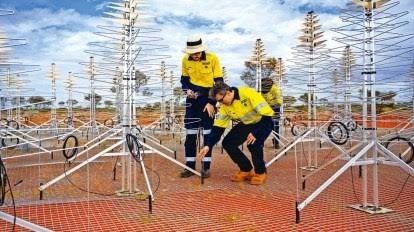
World’s Largest Radio Telescope Project

04.01.2024
World’s Largest Radio Telescope Project , Daily Current Affairs , RACE IAS : Best IAS Coaching in lucknow
|
For Prelims:What is a Radio Telescope?,About Giant Metrewave Radio Telescope (GMRT),National Centre for Radio Astrophysics,About Square Kilometer Array Observatory (SKAO), |
Why in the news?
Scientists in India will now also be part of the international mega-science project, the Square Kilometer Array Observatory (SKAO), that will function as the world’s largest radio telescope.
Key Point
India’s Giant Metrewave Radio Telescope (GMRT) is amongst the world’s six large telescopes.
What is a Radio Telescope?
- Radio telescopes detect and amplify radio waves from space, turning them into signals that astronomers use to enhance our understanding of the Universe.
- Stars, galaxies and gas clouds in space emit visible light as well as light from other parts of the electromagnetic spectrum in the form of radio waves, gamma rays, X-rays, and infrared radiation.
- In its simplest form a radio telescope has three basic components:
○One or more antennas pointed to the sky, to collect the radio waves
○A receiver and amplifier to boost the very weak radio signal to a measurable level, and
○A recorder to keep a record of the signal.
- Radio telescopes can be used both night and day.
About Giant Metrewave Radio Telescope (GMRT):
- It located near Narayangaon, Pune, is an array of 30 fully steerable parabolic radio telescopes of 45 metre diameter, observing at metre wavelengths.
- It is a low-frequency radio telescopethat helps investigate various radio astrophysical problems ranging from nearby solar systems to the edge of the observable universe.
- The telescope is operated by the National Centre of Radio Astrophysics (NCRA). It became operational in the year 2000.
- NCRA is a part of the Tata Institute of Fundamental Research (TIFR), Mumbai.
- GMRT is one of the most challenging experimental programmes in basic sciences undertaken by Indian scientists and engineers.
- Astronomers from all over the world regularly use this telescope to observe many different astronomical objects such as the Sun, Jupiter, exoplanets, magnetically active stars, etc.
- In 2021, GMRT became only the third in India to be recognised with the Institute of Electrical and Electronics Engineers (IEEE) Milestone facility.
National Centre for Radio Astrophysics:
- It is a research institution in India in the field of radio astronomy.
- It is located in the Pune University Campus.
- The Centre has its roots in the Radio Astronomy Group of TIFR, set up in the early 1960s under the leadership of Prof. Govind Swarup.
About Square Kilometer Array Observatory (SKAO):
- It is an intergovernmental international radio telescope project being built in Australia and South Africa.
- It is being built in the southern hemisphere as the view of the Milky Way galaxy is the best and radio interference at its least.
- Some of the countries taking part in building the SKA include the UK, Australia, South Africa, Canada, China, France, India, Italy and Germany.
Objective:
- To build and operate cutting-edge radio telescopes to transform our understanding of the Universe, and deliver benefits to society through global collaboration and innovation.
Construction
- The project has two phases of construction: the current SKA1, commonly just called SKA, and a possible later significantly enlarged phase sometimes called SKA2.
- The construction phase of the project began in December 2022 in both South Africa and Australia.
- Headquarters: Jodrell Bank Observatory, United Kingdom
India’s Role:
- India, through the NCRA and some other institutions, has been involved in the development of SKAO since its inception in the 1990s.
- India’s main contribution to the SKA is in the development, and operation, of the Telescope Manager element, the “neural network” or the software that will make the telescope work.
- NCRA led an international team from nine institutions and seven countries to develop the software.
- Countries have to sign, and ratify, the SKAO convention to formally become members.
- Recently, the Central Government decided to join the project, with a financial sanction of Rs 1,250 crore.
Source: The Hindu